Astronomers discover 7 Earth-sized planets orbiting nearby star 天文学家发现7个地球大小的行星绕着附近的星 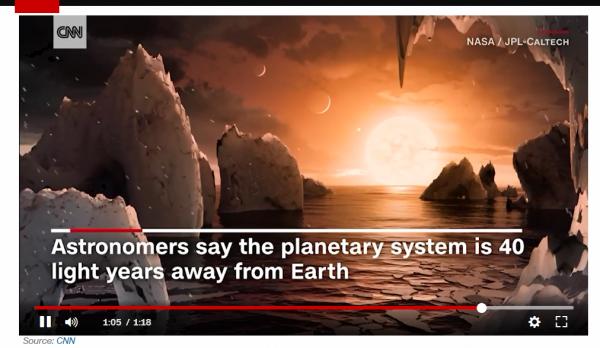
(CNN)根据星期三在自然杂志上发表的一项研究,天文学家发现至少有七个地球大小的行星围绕同一颗星40光年。研究结果还在美国国家航空航天局总部在华盛顿举行的新闻发布会上宣布。 这个在我们的太阳系之外的发现是罕见的,因为行星有类似于地球大小和温度,这意味着他们可以有水在他们的表面和潜在的支持生命的获胜组合。 比利时列日大学首席研究作者和天文学家米歇尔·吉隆说:“这是第一次在同一颗星上发现这么多行星。 七个外行星都发现在一个名为TRAPPIST-1的超冷星星附近的紧密形成。它们质量的估计也表明它们是岩石行星,而不是象木星那样的气体。三个行星在星的可居住区,被称为TRAPPIST-1e,f,g,甚至可能在表面上有海洋。 (CNN)Astronomers have found at least seven Earth-sized planets orbiting the same star 40 light-years away, according to a study published Wednesday in the journal Nature. The findings were also announced at a news conference at NASA Headquarters in Washington. This discovery outside of our solar system is rare because the planets have the winning combination of being similar in size to Earth and being all temperate, meaning they could have water on their surfaces and potentially support life. "This is the first time that so many planets of this kind are found around the same star," said Michaël Gillon, lead study author and astronomer at the University of Liège in Belgium. The seven exoplanets were all found in tight formation around an ultracool dwarf star called TRAPPIST-1. Estimates of their mass also indicate that they are rocky planets, rather than being gaseous like Jupiter. Three planets are in the habitable zone of the star, known as TRAPPIST-1e, f and g, and may even have oceans on the surface. 图片: http://i2.cdn.cnn.com/cnnnext/dam/assets/170221161852-trappist-1-planetary-system-large-169.jpg
TRAPPIST-1星,一个超冷的矮星,有七个地球大小的行星轨围绕它公转。 研究人员认为,TRAPPIST-1f特别是支持生命的最佳候选人。 它比地球有点冷,但可能适合与正确的气氛和足够的温室气体。 如果TRAPPIST-1听起来很熟悉,那是因为这些研究人员宣布发现三个初始行星在五月同一颗星上。 新研究将这个数字增加到7个行星。 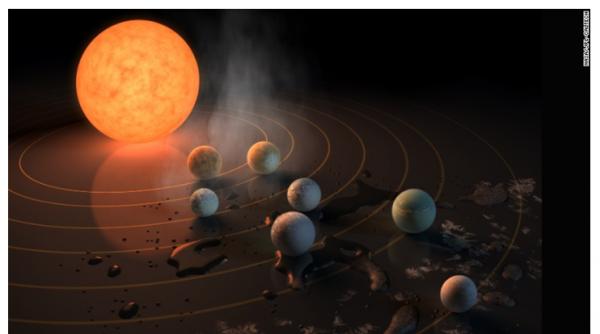
The TRAPPIST-1 star, an ultracool dwarf, has seven Earth-size planets orbiting it. The researchers believe that TRAPPIST-1f in particular is the best candidate for supporting life. It's a bit cooler than Earth, but could be suitable with the right atmosphere and enough greenhouse gases. If TRAPPIST-1 sounds familiar, that's because these researchers announced the discovery of three initial planets orbiting the same star in May. The new research increased that number to seven planets total.

Three Earth-like planets discovered orbiting dwarf star 剑桥大学的研究作者和天文学家之一Amaury Triaud说:“我认为我们已经朝着寻找是否存在生命迈出了关键的一步。 “我不认为任何时候,我们有正确的行星发现和发现是否有(生活)。在这里,如果生活成功地茁壮成长并释放类似于我们在地球上的气体,我们会知道。 生命可能在其他行星上开始和发展不同,因此发现表明生命的气体是关键,研究人员补充说。
"I think we've made a crucial step towards finding if there is life out there," said Amaury Triaud, one of the study authors and an astronomer at the University of Cambridge. "I don't think any time before we had the right planets to discover and find out if there was (life). Here, if life managed to thrive and releases gases similar to what we have on Earth, we will know." Life may begin and evolve differently on other planets, so finding the gases that indicate life is key, the researchers added. NASA科学任务局的副管理者托马斯·祖伯肯(Tony Zurbuchen)说:“这一发现可能是寻找适合居住环境,有利于生命的地方的重要组成部分。 “回答这个问题”我们孤独吗?是一个顶尖的科学重点,并找到这么多的行星,这是第一次在可居住区是朝着这个目标迈出的一个显着的一步。 正如我们从以前的研究和发现外行星学到的,有一个,还有更多,萨拉西格,马萨诸塞理工学院行星科学和物理学教授说。 Seager和其他研究人员被这个系统的发现所鼓励,因为它通过知道在哪里寻找,提高了我们找到另一个可居住的行星,如地球在未来的机会。 我们知道些什么? 行星彼此如此接近,恒星中有七个在比水星到太阳的距离小五倍的空间内。这种接近性使研究人员能够深入研究行星,获得对我们自己以外的行星系统的了解。 "This discovery could be a significant piece in the puzzle of finding habitable environments, places that are conducive to life," said Thomas Zurbuchen, associate administrator of NASA's Science Mission Directorate. "Answering the question 'are we alone?' is a top science priority, and finding so many planets like these for the first time in the habitable zone is a remarkable step forward toward that goal." And as we've learned from studying and discovering exoplanets before, where there is one, there are more, said Sara Seager, professor of planetary science and physics at Massachusetts Institute of Technology. Seager and other researchers are encouraged by the discovery of this system because it improves our chances of finding another habitable planet, like Earth, in the future, by knowing where to look. What we know The planets are so close to each other and the star that there are seven of them within a space five times smaller than the distance from Mercury to our sun. This proximity allows the researchers to study the planets in depth as well, gaining insight about planetary systems other than our own. 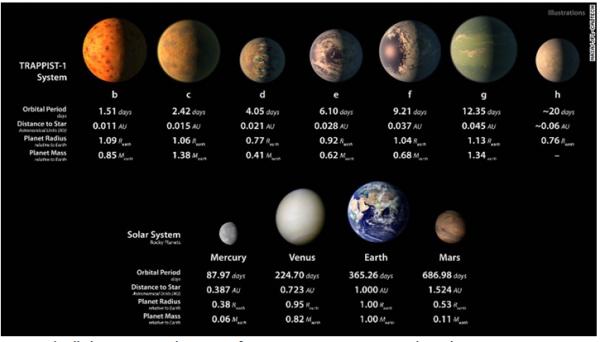
The seven planets of TRAPPIST-1 compared with Mercury, Venus, Earth and Mars.
从最接近星星和移出,行星有相应的公转轨道从一个半到近13个地球日。最远的行星的轨道仍然是未知的。 站在其中一个行星的表面,你会得到比你从太阳少200倍的光,但你仍然会收到尽可能多的能量,让你温暖,因为星星是这么近。它也将提供一些如诗如画的景色,因为其他行星将出现在天空像大月亮(或甚至两倍大)。 在TRAPPIST-1f,星将出现三倍大的太阳在我们的天空。并且由于星的红色性质,光将是一个鲑鱼色调,研究人员推测。 研究人员认为,行星距离恒星更远。然后,他们进入他们目前的阵容。这是令人难以置信的类似木星和它的伽利略卫星。 像月亮一样,研究人员认为最靠近恒星的行星被完全锁定。这意味着行星总是面向星的一条路。地球的一边永远是黑夜,而另一边总是白天。 Starting closest to the star and moving out, the planets have respective orbits from one and a half to nearly 13 Earth days. The orbit of the farthest planet is still unknown.
Standing on the surface of one of the planets, you would receive 200 times less light than you get from the sun, but you would still receive just as much energy to keep you warm since the star is so close. It would also afford some picturesque views, as the other planets would appear in the sky as big as the moon (or even twice as big). On TRAPPIST-1f, the star would appear three times as big as the sun in our sky. And because of the red nature of the star, the light would be a salmon hue, the researchers speculate. The researchers believe the planets formed together further from the star. Then, they moved into their current lineup. This is incredibly similar Jupiter and its Galilean moons. Like the moon, the researchers believe the planets closest to the star are tidally locked. This means that the planets always face one way to the star. One side of the planet is perpetually night, while the other is always day. 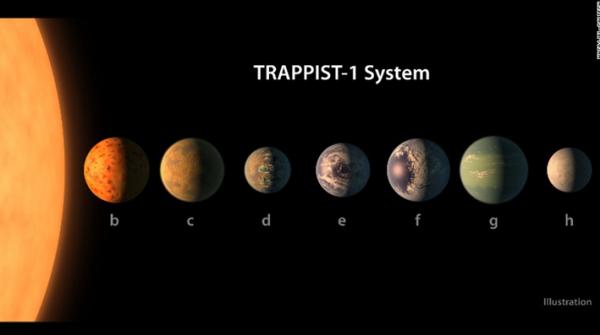
TRAPPIST-1行星系统可能是什么样子。 基于初步气候模拟,研究人员认为,最靠近恒星的三个行星可能太热,不能支持液态水,而最外面的行星TRAPPIST-1h可能太遥远和寒冷以支撑表面上的水。 但是需要进一步观察才能确定。 它们是如何被发现的 TRAPPIST-1甚至不能称为恒星, 它仅仅有比太阳低一半的温度,是太阳质量的十分之一, 红色,昏暗,只是比木星大一点。 但这些微小的超级冰星星在我们的星系中很常见。
What the TRAPPIST-1 planetary system may look like. Based on preliminary climate modeling, the researchers believe that the three planets closest to the star may be too warm to support liquid water, while the outermost planet, TRAPPIST-1h, is probably too distant and cold to support water on the surface. But further observation is needed to know for sure. How the discovery was made TRAPPIST-1 barely classifies as a star at half the temperature and a tenth the mass of the sun. It is red, dim and just a bit larger than Jupiter. But these tiny ultracool dwarf stars are common in our galaxy. 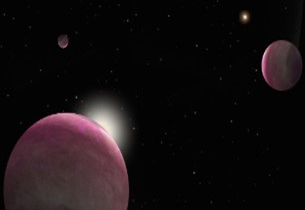
他们一直被忽视了,直到吉永决定研究这些矮星之一的空间。 研究人员使用一个称为TRAPPIST(TRAniting行星和PlanetesImals小望远镜)的望远镜观察它的星光和亮度的变化。 团队看到阴影,像小日食,定期打断星光的稳定模式。 这称为过渡。 阴影指示行星,并进一步观察证实了它们。 在7月,团队能够确定,通过在行星的大气中观察星光,两颗最接近恒星的星球具有比地球,金星和火星更加紧凑和可比的气氛。
They were largely overlooked until Gillon decided to study the space around one of these dwarfs. The researchers used a telescope called TRAPPIST (TRAnsiting Planets and PlanetesImals Small Telescope) to observe its starlight and changes in brightness. The team saw shadows, like little eclipses, periodically interrupting the steady pattern of starlight. This is called transiting. The shadows indicated planets, and further observation confirmed them. In July, the team was able to determine that two of the closest planets to the stars had atmospheres that were more compact and comparable to those of Earth, Venus and Mars by observing starlight through the planets' atmosphere. 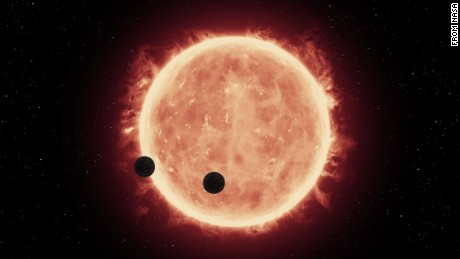
Taking a closer look at new Earth-like planets for the first time By using a global network ground-based telescopes like TRAPPIST and space-based telescopes like Spitzer, the researchers continued looking toward the TRAPPIST system and were able to determine the orbital periods, distances from their star, radius and and masses of the planets. What's next Over the next decade, the researchers want to define the atmosphere of each planet, as well as to determine whether they truly do have liquid water on the surface and search for signs of life. Although 40 light-years away doesn't sound too far, it would take us millions of years to reach this star system. But from a research perspective, it's a close opportunity and the best target to search for life beyond our solar system.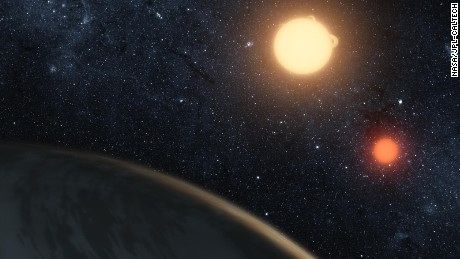 画家让我们靠近外星人的行星观察 Illustrators get us up close with alien planets “如果我们现在学习东西,它可以确定我们是否在正确的地方看,”吉永说。 在2018年,詹姆斯·韦伯空间望远镜将发射和定位距离地球100万英里,以前所未有的宇宙观。 它可以观察大的外行星和检测通过他们的大气过滤的星光。 研究人员也在寻找类似的星系统来进行更大气的研究。 位于智利的名为SPECULOOS(搜索可居住的行星Eclipsing ULtra-c001星)的四个望远镜将为此目的调查南部的天空。 这个星系统可能会超过我们,因为这种星星发展如此缓慢。 当我们的太阳死了,TRAPPIST-1将仍然是一个年轻的明星,并将活10,000亿年(译注: 我们的太阳仅仅还有40亿年寿命,到那时我们不得不逃离太阳,TRAPPIST-1是我们很好的备用系统 -- 避难所),吉利说。 在我们走了之后,如果宇宙的另一部分要继续生命,它可能在TRAPPIST-1系统中。
"If we learn something now, it can determine if we looked in the right place," Gillon said. In 2018, the James Webb Space Telescope will launch and be positioned 1 million miles from Earth with an unprecedented view of the universe. It can observe large exoplanets and detect starlight filtered through their atmosphere. The researchers are also searching for similar star systems to conduct more atmospheric research. Four telescopes named SPECULOOS (Search for habitable Planets EClipsing ULtra-cOOl Stars) based in Chile will survey the southern sky for this purpose. This star system will probably outlive us because this type of star evolves so slowly. When our sun dies, TRAPPIST-1 will still be a young star and will live for another trillion years, Gillon said. After we are gone, if there is another part of the universe for life to carry on, it may be in the TRAPPIST-1 system. 394/5000 NASA位于加利福尼亚州帕萨迪纳的Caltech / IPAC的Spitzer科学中心的经理Sean Carey说:“这是我在Spitzer运营的14年中见过的最令人兴奋的结果。 “斯皮策将在秋天跟进,进一步完善我们对这些行星的理解,以便詹姆斯·韦伯空间望远镜可以跟进,更多的系统观察肯定会揭示更多的秘密。
"This is the most exciting result I have seen in the 14 years of Spitzer operations," said Sean Carey, manager of NASA's Spitzer Science Center at Caltech/IPAC in Pasadena, California. "Spitzer will follow up in the fall to further refine our understanding of these planets so that the James Webb Space Telescope can follow up. More observations of the system are sure to reveal more secrets." Pasted from <http://www.cnn.com/2017/02/22/world/new-exoplanets-discovery-nasa/>
| 